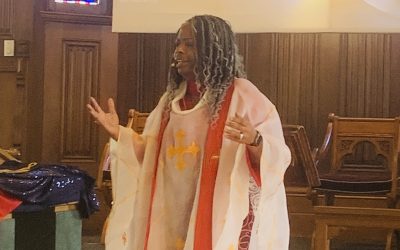Assistant Professor of Teacher Education Cathryn Devereaux carves the path forward
April 2022 – According to the New Jersey Department of Education (NJDOE), 56 percent of the 1.4 million children in the New Jersey public school system are of color. Yet only 16 percent of New Jersey teachers are of color.
Enlarge

The disparity is staggering. Research provided by the NJDOE cites that teachers of color serve as role models for all students by creating positive perceptions, advocating for social justice, and developing trusting relationships. Further, students who are exposed to diversity have improved cognitive skills, critical thinking, and problem-solving skills.
Drew’s Caspersen School of Graduate Studies Teacher Education program is committed to fostering change in the field of education by working to diversify New Jersey’s teacher population.
Drew is a part of the NJDOE Collaborative on Candidate and Completer Ethno-Racial Diversity initiative, and Cathryn Devereaux, assistant professor of education, is leading the efforts as the chair of the Diversity Collaborative Committee at Drew.
Devereaux, whose research centers around youth of color, equity, culturally responsive leadership, and anti-racism, earned her Doctorate of Education in Curriculum and Teaching with a concentration in Urban Education from Columbia University.
We recently sat down with Devereaux to learn more about her advocacy and the road ahead.
What are Drew’s initial initiatives to diversify New Jersey’s teacher population?
The Teacher Education faculty at Drew met with other teacher education programs across the state to exchange ideas and learn from each other. These discussions prompted us to do a deep internal review to take a look at Drew’s student and faculty diversity.
"I don’t want to just think outside of the box; I want to take the box and throw it out the window."
For me, it’s never been about increasing the number of students of color. It’s about creating and cultivating safe spaces for students of color to thrive. We have to reimagine, rethink, and restructure our program in ways that get us away from the white normative structure. It also means rethinking what we consider to be academic and intellectual, how we privilege certain things, and the content we’re presenting to our students.
Initially, we will be leaning on student voice. We do not, and cannot know what we are doing right as a program if we are not talking to our students with the hopes of gaining real responses. We will conduct focus groups in the spring with students and recent alums of color to hear about their experiences in our program and to obtain feedback on their perception of an ideal education program. I don’t want to just think outside of the box; I want to take the box and throw it out the window.
More work needs to and will be done to recruit and retain faculty of color; the representation needs to be there. In my own experience, I found safety in teachers who looked like me. Students need to be able to see themselves in the faculty that are present.
What led you to pursue a career in education?
When I began working at a juvenile detention center, I really started to see the gaps in the education system, along with gaps in opportunities for Black and Brown students from low income areas. I saw so many kids leave and come back, or leave and never come back because they were killed on the streets. It was heartbreaking.
I saw patterns in reading levels and math skills that lead me to the realization that we need to jump in earlier and start planting seeds and building up Black and Brown students at a younger age. They need to be seen and heard and valued in schools—and not criminalized.
My scholarship centers on marginalized communities and youth voice. I’m working on a documentary now on the intersections of education and Black girlhood. It all started in that juvenile detention center and morphed throughout the years into a passion to focus on the stories not being told.
Talk to us about Drew’s new Equity, Justice, and Education in the United States course, which encourages students to seek solutions to problems of inequity.
The course will allow students to explore these critical issues in the field of education and look at it through a lens of diversity and social justice. We’ll examine how institutions privilege some groups while marginalizing others. Students will explore historical and present day inequities in education while providing space to unpack their personal connections and relationships to issues related to race, power, class, gender, sexual orientation, ability, and more.
What brought you to Drew University?
My heart has always been in the work of educational equity and cultivating safe spaces for people of color. What attracted me to Drew was the honest acknowledgement that there is work to be done, and my belief that we are ready to do this work here now. We want to authentically dive into the issues. It’s not about numbers or checking boxes, but creating real experiences.
A student of color at Drew recently told me I was only the second teacher of color they ever had. This validated my reason for coming to Drew and doing this work. This is exactly where I need to be.


